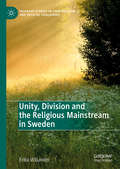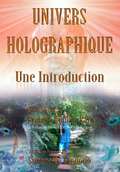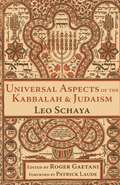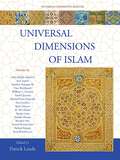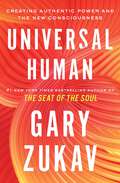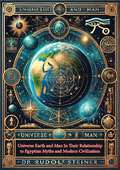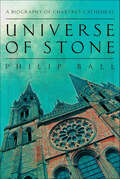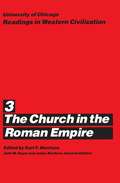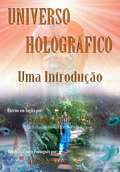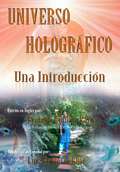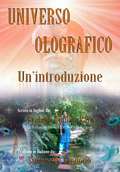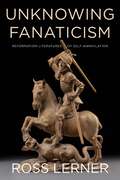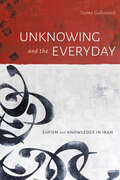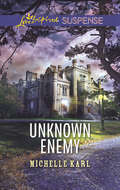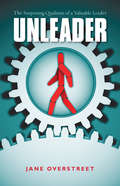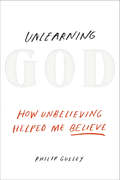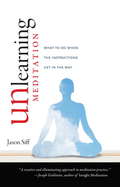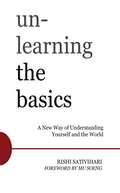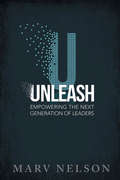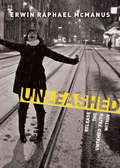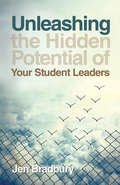- Table View
- List View
Unity in Faith?: Edinoverie, Russian Orthodoxy, and Old Belief, 1800–1918
by J. M. WhiteThe little known history of an attempt to end a religious schism in imperial Russia, and the questions it raised about church and state.Established in 1800, edinoverie (translated as “unity in faith”) was intended to draw back those who had broken with the Russian Orthodox Church over ritual reforms in the seventeenth century. Called Old Believers, they had been persecuted as heretics. In time, the Russian state began tolerating Old Believers in order to lure them out of hiding and make use of their financial resources as a means of controlling and developing Russia’s vast and heterogeneous empire.However, the Russian Empire was also an Orthodox state, and conversion from Orthodoxy constituted a criminal act. So, which was better for ensuring the stability of the Russian Empire: managing heterogeneity through religious toleration, or enforcing homogeneity through missionary campaigns? Edinoverie remained contested and controversial throughout the nineteenth and early twentieth centuries, as it was distrusted by both the Orthodox Church and the Old Believers themselves. The state reinforced this ambivalence, using edinoverie as a means by which to monitor Old Believer communities and employing it as a carrot to the stick of prison, exile, and the deprivation of rights.In Unity in Faith?, James White’s study of edinoverie offers an unparalleled perspective of the complex triangular relationship between the state, the Orthodox Church, and religious minorities in imperial Russia.
Unity, Division and the Religious Mainstream in Sweden (Palgrave Studies in Lived Religion and Societal Challenges)
by Erika WillanderThis book presents new conceptual and methodological approaches to studying religiosity in Europe. From her unique background of working with the Church of Sweden statistics and official statistics on the increasing religious diversity in Sweden, Willander illustrates how previous and current methods of analysing religiosity overlook substantial aspects in patterns of affiliation, belief and practice. Unity, Division and the Religious Mainstream in Sweden draws on the sociological imagination in the sociology of religion to offer a new and empirically-driven analytical framework that shifts the focus to religious change in general, and will contribute greatly to ongoing discussions about majority forms of religiosity and their social relevance in contemporary times. It will be of use to students and scholars with a focus on the sociology of religion, as well as sociology, political science, epistemology and media studies.
Univers Holographique: Une Introduction
by Brahma Kumari Pari SimonaLisez ce livre dans l'intention de comprendre les profondeurs de ce qui est expliqué. Ne considérez pas seulement comme «matériel de lecture». Au lieu de simplement lire le livre pour connaître l'Univers Holographique, continuez à contempler ce que l'autrice a dit jusqu'à ce que vous rencontriez et compreniez ce qui se dit sur l'Univers Holographique. Garder un esprit ouvert et clair (tout en visualisant ce qui est lu) vous aidera à expérimenter ce que l'autrice a vécu et/ou vous pourriez avoir d'autres expériences pertinentes. En conséquence, vous pourrez comprendre ce que l'autrice explique. Votre capacité à avoir des expériences dans l'Univers Holographique augmentera, car vous continuez à lire ce livre encore et encore jusqu'à ce que vous l'avez compris. Il y a des explications, dans cet livre, sur: 1. les différentes divisions et la nature de l'univers holographique. 2. comment tout se passe selon le Drame Mondial (registres akashiques). 3. comment les gens vivent dans deux types de mondes, le monde réel et le monde holographique, en même temps. 4. le film holographique de l'hologramme auquel nous participons. 5. comment les différents types de mondes existent. 6. comment les énergies quantiques matérialisent les corps physiques et le monde physique à travers l'Univers Holographique. 7. comment le processus de création se déroule à travers les vortex et les chakras. 8. comment les dimensions subtiles, les corps holographiques et les corps subtils sont créés. 9. comment l'aura est utilisée pendant les expériences. 10. comment les énergies quantiques de densités différentes matérialisent un type différent de monde réel dans lequel nous vivons. 11. comment l'Univers Holographique change quand le monde se transforme. 12. la méditation et la connaissance de Brahma Kumaris. 13. Expériences près de la mort. 14
Universal Aspects of the Kabbalah and Judaism
by Leo SchayaLeo Schaya (1916-1986) was a brilliant author and editor whose only book to appear in English was the much-acclaimed The Universal Meaning of the Kabbalah, which is often cited in books on Jewish mysticism. This new book, Universal Aspects of the Kabbalah and Judaism, is a collection of writings by Schaya, including some previously unpublished material, that highlight the particular way in which Judaism expresses universal truths and concepts. Schaya explains in great depth and beauty how the God of Israel manifests His goodness, power, and mercy in multiple levels of creative emanations, which are the main focus of the Kabbalah. Even more, however, Schaya looks through Judaism&’s particular forms and demonstrates that at its core Judaism reveals the same mysterious universal source from which all of the great religious traditions of the world draw their spiritual sustenance and energy. Please note: This ebook contains foreign characters that may not be visible on all ebook devices.
Universal Dimensions of Islam: Studies in Comparative Religion
by Patrick LaudeIslam's acceptance of other religions remains an enigma for many Westerners. The 16 essays in this volume, by renowned experts on Islam such as Frithjof Schuon, Rene Guenon, Titus Burckhardt, and Seyyed Hossein Nasr, explore the fundamental universality of the world's second largest religion, presenting an incisive portrait of Islam that is seldom seen in the mass media. This book is another volume in World Wisdom's Studies in Comparative Religion series.
Universal Human: Creating Authentic Power and the New Consciousness
by Gary ZukavThe author of the legendary #1 New York Times bestseller The Seat of the Soul shows us step-by-fascinating-step how to create a life of love and where that will lead for humanity in this &“unique and transformative book&” (Ellen Burstyn, Academy Award–winning actress). Internationally acclaimed author and teacher, Gary Zukav, shares a new vision of power and hope in this time of extraordinary transformation. Universal Human gives us fresh tools to grow spiritually and shows us how to transform everyday experiences of hopelessness, emptiness, and pain into fulfillment, meaning, and joy. With his accessible and life-changing prose, he points us toward a startling new destination—a species that is beyond culture, religion, nation, ethnic group, and gender, a species whose allegiance is to Life first and all else second—and shows us how to get there. Universal Human examines our disintegrating social structures and the new ones that are replacing them. It shows us a new creation story—our new creation story—as we create it with our choices, our deeds, and our words. Authentic power—the alignment of the personality with soul—is replacing external power, the ability to manipulate and control. Zukav explains that the potential of a new era of humanity based on love instead of fear is upon us, but only we can bring it into being. Universal Human shows us how and &“offers a ray of hope&” (Booklist) for us all.
Universal Reconciliation: A Brief Selection of Pertinent Quotations
by Michael PhillipsThe Christian theological scholar presents a collection of essential writings both for and against the controversial doctrine of universal reconciliation. As an expert on the theological writings of George MacDonald, Michael Phillips is often asked to clarify the Victorian author&’s views on the afterlife. Since MacDonald himself never presented a doctrinal position on the subject, debate has raged for more than a century about whether he believed in eternal punishment or universal reconciliation. Rather than take a side on the issue, Phillips offers this broad selection of readings on the subject in order to help readers to make up their own minds. Universal Reconciliation is a comprehensive primer on the debate surrounding this controversial doctrine, including excerpts by MacDonald as well as A.R. Symonds, Andrew Jukes, Hannah Hurnard, and others. A thorough list of Scriptures is also included, giving scriptural evidence both for and against universalism.
Universe Earth and Man In Their Relationship to Egyptian Myths and Modern Civilization
by Dr Rudolf SteinerUniverse, Earth and Man In Their Relationship to Egyptian Myths and Modern Civilization by Dr. Rudolf Steiner is a profound exploration of the connections between ancient wisdom and contemporary life, offering a unique perspective on the spiritual and cosmic forces that have shaped human civilization. In this illuminating work, Steiner, a renowned philosopher, educator, and founder of anthroposophy, delves into the esoteric knowledge of ancient Egypt, revealing its enduring relevance to modern society.Steiner examines the symbolic and spiritual significance of Egyptian myths, particularly their understanding of the cosmos, the Earth, and humanity’s place within the grand design of the universe. He explains how the ancient Egyptians perceived the universe as a living, interconnected organism, with the Earth and humanity playing integral roles in its ongoing evolution. Steiner explores how these ancient insights can inform our understanding of modern civilization, shedding light on the deeper spiritual currents that continue to influence human progress.Universe, Earth and Man also addresses the relationship between mythology and science, suggesting that ancient myths contain profound truths about the nature of reality that modern science is only beginning to uncover. Steiner draws parallels between the spiritual teachings of ancient Egypt and the challenges and opportunities faced by contemporary society, offering a path toward greater spiritual awareness and harmony with the cosmos.This book is essential reading for those interested in the intersections of ancient wisdom, spirituality, and modern culture. Steiner’s insights encourage readers to look beyond the materialistic worldview and rediscover the spiritual dimensions of life that have been recognized by civilizations throughout history.Universe, Earth and Man In Their Relationship to Egyptian Myths and Modern Civilization is a timeless work that continues to inspire and guide those seeking a deeper understanding of the forces that shape our world. Dr. Rudolf Steiner’s visionary teachings offer a bridge between the ancient and modern, providing valuable insights for anyone interested in the spiritual evolution of humanity.
Universe Lost: Reclaiming a Christian World View
by Stuart CookThe author draws his own personal interpretation of reality from the Bible.
Universe of Stone: Chartres Cathedral and the Invention of the Gothic
by Philip Ball“[A] lively biography of Chartres Cathedral . . . Ball’s account of its construction reveals fascinating details.” —The New YorkerChartres Cathedral, south of Paris, is revered as one of the most beautiful and profound works of art in the Western canon. But what did it mean to those who constructed it in the twelfth and thirteenth centuries—and why was it built at such immense height and with such glorious play of light, in the soaring manner we now call Gothic?In this work, Aventis Prize winner and National Book Critics Circle Award finalist Philip Ball makes sense of the visual and emotional power of Chartres and brilliantly explores how its construction—and the creation of other Gothic cathedrals—represented a profound and dramatic shift in the way medieval thinkers perceived their relationship with their world.Beautifully illustrated, filled with astonishing insight, Universe of Stone embeds the magnificent cathedral in the culture of the twelfth century—its schools of philosophy and science, its trades and technologies, its politics and religious debates—enabling us to view this ancient architectural marvel with fresh eyes.“A terrific book . . . a lucid, thoughtful tour de force.” —The Christian Science Monitor“Engrossing . . . a resplendent account of the mysteries of Chartres Cathedral.” —Sunday Times“There is no better introduction to the subject.” —The Wall Street Journal
University of Chicago Readings in Western Civilization, Volume 3: The Church in the Roman Empire
by John W. Boyer Julius Kirshner Edited by Karl F. MorrisonThe University of Chicago Readings in Western Civilization (nine volumes) makes available to students and teachers a unique selection of primary documents, many in new translations. These readings, prepared for the highly praised Western civilization sequence at the University of Chicago, were chosen by an outstanding group of scholars whose experience teaching that course spans almost four decades. Each volume includes rarely anthologized selections as well as standard, more familiar texts; a bibliography of recommended parallel readings; and introductions providing background for the selections. Beginning with Periclean Athens and concluding with twentieth-century Europe, these source materials enable teachers and students to explore a variety of critical approaches to important events and themes in Western history. Individual volumes provide essential background reading for courses covering specific eras and periods. The complete nine-volume series is ideal for general courses in history and Western civilization sequences.
Universo Holográfico: Uma Introdução
by Brahma Kumari Pari Aline SassonNeste livro, as explicações sobre o Universo Holográfico estão baseadas na Mecânica Quântica, no conhecimento da Brahma Kumaris, em pesquisas, em experiências da autora, no conhecimento dos chacras e da aura, nos antigos textos Hindus, na orientação de Deus, etc. Há explicações neste livro sobre: As várias divisões e a natureza do Universo Holográfico. Como as energias quânticas materializam o corpo físico e o mundo físico através do Universo Holográfico. Como as pessoas vivem em dois tipos de mundos, o Mundo Real e o Mundo Holográfico, ao mesmo tempo. Como as energias quânticas de diferentes dimensões materializam um tipo diferente de Mundo Real para que vivamos nele. Como as dimensões sutis, corpos holográficos e corpos sutis são criados. Como acontece o processo de criação através e vórtices e chacras. O filme Holográfico do Holograma do qual participamos. Como o Universo Holográfico muda quando o mundo se transforma. Como tudo acontece de acordo com o Drama do Mundo (Registros Akáshicos). A Meditação e o Conhecimento d Brahma Kumaris. Como a aura é usada durante as experiências. Como existem vários tipos de mundos. A Consciência Cósmica. Experiências de Quase-Morte. As explicações neste livro, no Universo Holográfico, ajudarão o leitor a compreender o conteúdo do livro “Enriqueça na Caminhada para o Mundo da Era de Ouro (com Comentários de Meditação)”. Maiores explicações sobre o Universo Holográfico também serão encontradas no livro da autora “Enriqueça na Caminhada para o Mundo da Era de Ouro (com Comentários de Meditação)”.
Universo Holográfico: Una Introducción
by Brahma Kumari Pari Luis Rentería RuizMediante la lectura de este libro, usted tendrá una mejor comprensión del Universo Holográfico y se incrementará su habilidad para tener experiencias en él. Al mantener una mente clara y abierta (conforme avanza en su lectura), puede experimentar lo que el vivido y será capaz de entender lo que el autor está explicando. No considere el libro simplemente un "material de lectura", vaya más allá de las palabras y leálo con la intención de comprender a profundidad lo que se explica. Su capacidad de contemplar y experimentar el Universo Holográfico aumentará mientras continúe leyendo este libro una y otra vez hasta que lo haya comprendido.
Universo Olografico: Un'introduzione
by Brahma Kumari Pari Simona De GregorioUn'introduzione all'Universo Olografico, passando per i vari mondi coinvolti, i chackra, Dio stesso, le anime e le conoscenze BK.
Unknowing Fanaticism: Reformation Literatures of Self-Annihilation
by Ross LernerWe may think we know what defines religious fanaticism: violent action undertaken with dogmatic certainty. But the term fanatic, from the European Reformation to today, has never been a stable one. Then and now it has been reductively defined to justify state violence and to delegitimize alternative sources of authority. Unknowing Fanaticism rejects the simplified binary of fanatical religion and rational politics, turning to Renaissance literature to demonstrate that fanaticism was integral to how both modern politics and poetics developed, from the German Peasants’ Revolt to the English Civil War.The book traces two entangled approaches to fanaticism in this long Reformation moment: the targeting of it as an extreme political threat and the engagement with it as a deep epistemological and poetic problem. In the first, thinkers of modernity from Martin Luther to Thomas Hobbes and John Locke positioned themselves against fanaticism to pathologize rebellion and abet theological and political control. In the second, which arose alongside and often in response to the first, the poets of fanaticism investigated the link between fanatical self-annihilation—the process by which one could become a vessel for divine violence—and the practices of writing poetry. Edmund Spenser, John Donne, and John Milton recognized in the fanatic’s claim to be a passive instrument of God their own incapacity to know and depict the origins of fanaticism. Yet this crisis of unknowing was a productive one. It led these writers to experiment with poetic techniques that would allow them to address fanaticism’s tendency to unsettle the boundaries between human and divine agency and between individual and collective bodies. These poets demand a new critical method, which this book attempts to model: a historically-minded and politicized formalism that can attend to the complexity of the poetic encounter with fanaticism.
Unknowing and the Everyday: Sufism and Knowledge in Iran
by Seema GolestanehIn Unknowing and the Everyday Seema Golestaneh examines how Sufi mystical experience in Iran shapes contemporary life. Central to this process is ma’rifat, or “unknowing”—the idea that, as it is ultimately impossible to fully understand the divine, humanity must operate from an engaged awareness that it knows nothing. Golestaneh shows that rather than considering ma’rifat an obstacle to intellectual engagement, Sufis embrace that there will always be that which they do not know. From this position, they affirm both the limits of human knowledge and the mysteries of the profane world. Through ethnographic case studies, Golestaneh traces the affective and sensory dimensions of ma’rifat in contexts such as the creation of collective Sufi spaces, the interpretation of Persian poetry, formulations of selfhood and non-selfhood, and the navigation of the socio-material realm. By outlining the relationship between ma’rifat and religious, aesthetic, and social life in Iran, Golestaneh demonstrates that for Sufis the outer bounds of human thought are the beginning rather than the limit.
Unknown Enemy: Faith in the Face of Crime (Mills And Boon Love Inspired Suspense Ser. #4)
by Michelle KarlA college professor attracts dangerous assassins—and a handsome bodyguard to keep her safe—in this inspirational romantic suspense.For professor Ginny Anderson, translating a set of ancient tablets could be the coup of her career—or more danger than she can handle. Someone doesn’t want the secrets of the artifacts to be revealed . . . and they’ll kill to bury her discoveries. But former Secret Service agent Colin Tapping refuses to let anybody hurt Ginny and appoints himself as her protector—whether she wants one or not. Colin has made mistakes in the past, and keeping Ginny safe could be just what he needs to prove he’s still a capable agent and win back his job. But is he willing to risk paying the ultimate price to reclaim his former life?
Unlawfully Wedded Bride
by Noelle MarchandKate O'Brien can't believe her ears. She's been married, by proxy, to a man she's never met, thanks to her young siblings' meddling! Kate offers her "groom" room and board at her farm until the annulment is granted-nothing more. After all, what else could this predicament be but a blunder that needs fixing?Nathan Rutledge arrives on Kate's doorstep, seeking a fresh start-with a family that needs his help more than Kate will admit. The shadows in both their pasts will be no match for a bright new beginning. But first, he has to convince a woman frightened of love to throw caution to the Texas wind...
Unleader: The Surprising Qualities of a Valuable Leader
by Jane OverstreetWhat kind of leader would you be if you were suddenly handed more power? What if you got that promotion you wanted or a headhunter called tomorrow offering you your dream job? Would your leadership be an example of servanthood and justice, or would you give in to the temptations that power always presents? In the time it took Samuel to pour oil on each of their heads, Saul and David both moved from unknown kids to kings of Israel. Their responses to that promotion had radically different outcomes. Saul made God sorry he had made him king. David brought joy to God as a man after his own heart. What about you? What would happen if God suddenly promoted you? A simple way to find out is to evaluate what your leadership looks like right now, and this book gives you the opportunity to do just that. Read about the intriguing similarities between Saul and David and the different choices they made that shaped their leadership. Then compare basic qualities of your leadership to each of theirs. You may be surprised at the qualities God values in a leader. Leadership development is a lifetime process. No matter your age or leadership experience, there is still time to grow into a leader that brings more joy to God's heart. Take the journey. It could have some wonderful rewards.
Unlearning God: How Unbelieving Helped Me Believe
by Philip GulleyAmerica's favorite Quaker storyteller explores the terrain of faith and doubt as shaped by family, church, and young love, finding his way to a less convenient but fully formed adult spirituality.Most of us grow up taking in whole belief systems with our mother's milk, only to discover later that what we received as being certain is actually nothing like it. And then we're faced with a choice--retreat to spiritual security and the community that comes with it, or strike out into the unknown. With his trademark humor and down-home wisdom, Philip Gulley serves as just the spiritual director a wayward pilgrim could warm to, inviting readers into his own sometimes rollicking, sometimes daunting journey of spiritual discovery. He writes about being raised by a Catholic mother and a Baptist father across the street from a family of Jehovah's Witnesses--all three camps convinced the others are doomed. To nearly everyone's consternation, Philip grows up to be a Quaker and a pastor. In Unlearning God, Gulley showcases his well-loved gift as a storyteller and his acute sensibilities as a public theologian in conversations that will charm, provoke, encourage, and inspire.
Unlearning Meditation: What to Do When the Instructions Get In the Way
by Jason SiffWhen we meditate, our minds often want to do something other than the meditation instructions we've been taught. When that happens repeatedly, we may feel frustrated to the point of abandoning meditation altogether. Jason Siff invites us to approach meditation in a new way, one that honors the part of us that doesn't want to do the instructions. He teaches us how to become more tolerant of intense emotions, sleepiness, compelling thoughts, fantasies--the whole array of inner experiences that are usually considered hindrances to meditation. The meditation practice he presents in Unlearning Meditation is gentle, flexible, permissive, and honest, and it's been wonderfully effective for opening up meditation for people who thought they could never meditate, as well as for injecting a renewed energy for practice into the lives of seasoned practitioners.
Unlearning the Basics
by Mu Soeng Rishi SativihariIn fresh and inviting language and making frequent use of strikingly clear diagrams and illustrations, Unlearning the Basics challenges many of our common-sense understandings about ourselves and the world. The author lays out a new way of seeing that enables us to live more serenely, more compassionately, and more free from the slings and arrows of our busy lives. Along the way, Rishi Sativihari looks at love and grasping, at "the great unfixables," and at how vulnerability and pain feed the "evolution of character" -all in the service of helping us return to our true home and find new ways to flourish. Grounded in the Buddhist tradition yet completely free from the formulas of traditional, tired presentations, Unlearning the Basics has an informal, straightforward style that will immediately captivate the reader.
Unleash: Empowering the Next Generation of Leaders
by Marv NelsonAs older church leaders, we’ve been told a million times that the Millennials and Gen Xers who are coming up behind us don’t think like we think. We don’t get it and it frustrates us. Guess what? We need to get over it and let it go. Because, get this: it’s up to us to mentor and empower the generations that follow us into church leadership. Sadly, many of us are doing just the opposite; we’re turning them away. So, not only do we need to let go of our ways of doing things, we need to release our young leaders…release them to be the leaders they know they can be. Unleash provides thought-provoking ideas and practical, real-time examples that will help us learn to know, equip, and expectantly release our younger church leaders into the future with trust and confidence. I am completely weary of dismissive and demeaning articles and books focused on the weak, lazy, entitled character of Millennials and Gen Z.This book is different -- it's helpful and hopeful. I'm glad to have a book to recommend to people leading younger generations into their full capacities - Mark Oestreicher, Partner, The Youth Cartel Marv Nelson knows that unleashing young leaders must come from an accurate awareness of their emotional, mental and spiritual capabilities plus the right amount of equipping, encouragement and trust. This book is a valuable resource. - Michael Frost, author, Surprise the World
Unleashed
by Erwin Raphael McmanusTwo thousand years later the call to follow Christ has been repacked to be smooth and trouble-free, filled with opportunity and promise but lacking risk, passion, and sacrifice. Is this really what Jesus died for? If He chose the way of the cross, where would He hesitate leading us? Is it possible that to follow Jesus is to live your life completely unleashed?Jesus never made a pristine call to a proper or safe religion. Jesus beckons His followers to a path that is far from the easy road. It is a path filled with adventure, uncertainty, and unlimited possibilities- the only path that can fulfill the deepest longings and desires of your heart.This is the barbarian way: to give your heart to the only One who can make you fully alive. To love Him with simplicity and intensity. To unleash the untamed faith within. To be consumed by the presence of a passionate and compassionate God. To go where He sends you, no matter the cost.Previously released as The Barbarian Way
Unleashing the Hidden Potential of Your Student Leaders
by Jen BradburyUnleashing the Hidden Potential of Your Student Leaders lays out a theological and philosophical outline for effective student leadership in a youth ministry context. Additionally, it provides practical tips on how best to create and develop student leaders as well as how to help them transition into leadership positions in the broader church. The book draws from Scripture in general and from Jesus' ministry with his disciples in particular to explore the important work of developing students into leaders. Jen also draws from her own experience as a youth worker to inspire and equip both rookie and veteran youth leaders.

